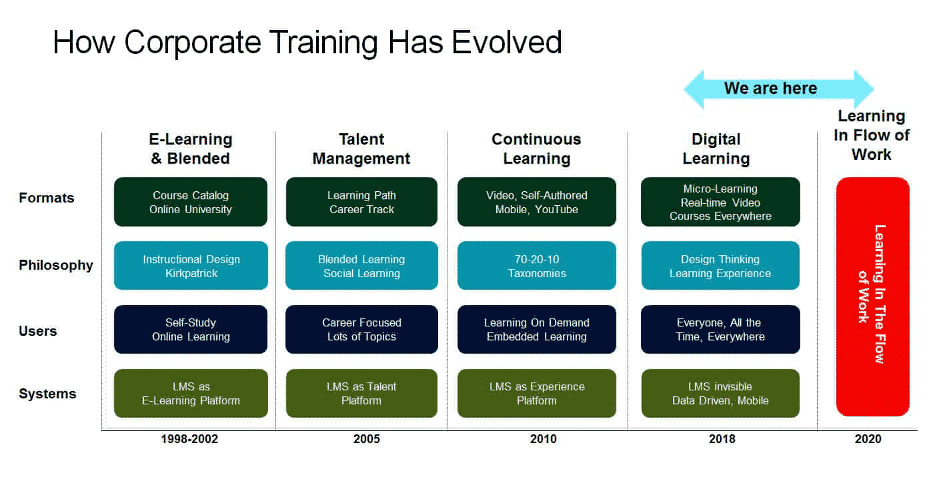
Why do corporate training programs matter? It’s simple: every organization is only as good as its workforce, and the level of productivity of each team can be significantly affected by training initiatives in corporate data fleuncy. According to a study, 237 employees from 3 states in the United States were studied to understand the relationship between training and improved work attitude. It was shown that 86.8% of those who underwent the training program showed improved job performance and attitude towards work. This indicator is what most employees understand and why they are willing to invest their time into corporate training programs.
Since the introduction of this method of learning and development, we have seen an astronomical rise in most workspace’s productivity level.
To further illustrate the need for corporate training programs, this article will guide employers on what corporate training programs entail, including the types of corporate training programs.
What are Corporate Training Programs?
These are opportunities given to learners and employees designed to provide the necessary knowledge and skillset to carry out their jobs. For large establishments, the Learning and Development/Talent teams carry out this role. For smaller ones, the human resources unit ensures that corporate training programs are available to their employees.
As a leader, you need to ensure corporate training program take a front seat in your company because:
- With your staff equipped with the best knowledge they need for their assigned job, you are assured of getting 100% output, increased efficiency, and this, in turn, will lead to significant profit.
- When your staff has all the right tools to work, they have increased motivation to carry out their assigned roles. Your team will derive joy while carrying out tasks without hassle or stress.
- Training your employees will ensure the company’s core values and policies will be maintained. At the same time, you keep a team of loyal employees who will remain grateful for an opportunity to learn while earning money.
- Your employees will remain top-notch and prepared since they stay ahead of industry changes by constant corporate learning and development.
- With this culture and habit instilled in employees, they are reminded of the need for constant development, training, research, and studies in other areas of their lives.
With this in mind, it’s clear these programs are advantageous to both your employees and the company. However, it is most valuable when the right method is chosen to suit your organization’s structure and employees.
4 Different Methods Of Corporate Learning And Development
Employers carry out different approaches to ensure continual corporate learning occurs within their organization. Here are four methods to consider:
MICROLEARNING
This is a self-directed learning approach where employees are trained with bite-sized content. It is usually extended over some time and sessions. This approach allows learners to access information at their own pace.
You can think of a microlearning approach where an establishment makes available a small pool of resources uploaded at its website for employees to learn with short video clips attached, especially for new employees. You can check your employees’ performance by frequently giving short tests on the materials used to learn.
Walmart is one of the world’s largest distribution networks that move products worldwide with specific safety challenges. Walmart wanted to find a way to decrease the associated cost that comes with injuries, risks, and accidents.
They decided to use an E-learning vendor that provides a platform for upskilling employee knowledge and gives the employee the experience they require to deliver a positive output.
Through this microlearning approach, Walmart was able to provide employees with the training required to ensure safety remains a top priority.
VIRTUAL REALITY (VR):
This is an interactive corporate training program that utilizes technology to provide virtual scenarios to simulate cases in everyday workspaces.
You can consider this approach very useful for job roles that require hands-on and real-life practices. With this method, the employee learns both motor skills and soft skills; which allows them to interact with and receive positive feedback from an expert or instructor of the course.
This method helps your employees learn a large amount of complex information, especially information that benefits from using engaging, visual scenarios. As an employer, Virtual Reality also provides you with the opportunity to teach a larger number of employees in a cost-effective method.
For some employees, this approach will be more effective since the visual format provides employees with quality images and scenarios, which increases their retention rate.
Additionally, VR provides an exciting experience for a novice; a new employee can carry out tasks without risks or injuries in the simulation. For instance, a new fork lifter can use VR to carry out job roles without fear of harm or dangers, which would be very scary and dangerous for them in real-life scenarios.
VR is used by different industries ranging from manufacturing, military, medical, pharmaceutics, firefighters, automotive, and space. VR is used to supplement the traditional training method, especially for companies such as Porsche and Walmart, that require both theory and hands on-field training.
SIMULATIONS:
This learning method offers employers the opportunity to help employees pick up the vital skills needed for their assigned job roles. If done well, it’s an effective training method because it provides realistic scenarios.
Leaders start by offering employees a real-life problem to carry out. After the simulation, an expert briefs employees on what went wrong and what they correctly executed. The expert exposes employees to different life situations and how best to improve and attempt such instances.
Simulations are a top-ranked corporate training method since they develop soft skills in employees like critical thinking, leadership skills, and interpersonal skills.
A key to the success of this learning approach is providing an expert during training for corrections, stating what went wrong, what employee behavior is expected to play out, and comparable situations around the scenarios. Without the expert there to facilitate these necessary corrections and explanations the simulation is far less effective.
This corporate learning and development approach is good for employees who prefer tactile learning by trying hands-on practical situations rather than visual or auditory materials.
Gamification
Who says learning can’t be fun? Gamification is a learning method that continues to gain traction in the market as employees demand a more engaging learning experience. This method has many different approaches, but typically it includes different rewards systems in the forms of badges, level rewards, gradings, rankings, and leaderboards. It aims at inspiring employees while at the same time, creating a fun learning environment for employees.
This form of training can be incorporated in almost any conventional training method. However, employers can’t assume just adding in points and rewards to traditional learning will suddenly change employee engagement and appetite to learn. It’s helpful to align gamification with company culture and make sure incentives are aligned with what employees actually want.
Below is a chart that depicts how corporate training has evolved over the years

OTHER TRAINING TRENDS
Due to the diverse training requirements for different companies, you can combine all 4 corporate training approaches. It’s important to create a comprehensive training program that best fits your unique work culture and the skills required. Two other recent trends you might consider adding to your corporate learning strategy are:
- Social Interaction: This entails small doses of interaction on platforms with peers and experts. Social interaction can be done via a social media platform where employees interact before training as a preparation tool, during training, and after training for feedback and notes.
- Adaptive Learning: This corporate training program creates models of the employee’s current knowledge skillset, opening the employee’s mind to an unmet need that requires instruction and additional skill. You can see adaptive learning as a training method that’s a better-customized with the microlearning approach.
It is essential to ensure your business doesn’t stand still because of the amount invested into your employees in the form of training. However, you are encouraged to properly use the right resources and best practices to produce excellent, hardworking and knowledgeable employees.
Strategies To Improve Corporate Training
As an employer, you can improve your ongoing corporate training by:
- Making learning easy and convenient for your employees:
It would help if you considered your employee’s workload and any pressure they might be facing. You are encouraged to ensure that all modules can be readily accessed while providing an excellent intuitive user interface.
Depending on the job role, it is advised to encourage traditional training methods that are short and snappy. It makes it easier for employees to get information and learn at a fast and convenient pace.
- Inspire Your Manager’s Participation:
In whatever way you look at it, these managers know your employees better than you do as the CEO. They know all about their team members skillset and each employee’s skill needs. Your manager will also go a long way in providing valuable support and encouragement to his direct team members and yourself as the CEO.
You can get your manager directly involved in your training after a session by directing the employees to carry out an assigned task with the manager. That way, your manager instantly checks your employees to ensure they meet up with what’s expected of them at that stage.
- Use Tools that Support both Remote and in-Office Employees and create a room for interaction so learners can share their opinions and experiences.
- Match different employees learning choices based on preferences and physical disabilities if any.
- It is essential you communicate with your employees and create feedback channels to get honest reviews from employees on how they think their skills can be improved.
References:
https://www.talentlms.com/blog/six-ways-improve-ongoing-training-for-employees/
https://www.business.com/articles/trends-in-corporate-training/
https://www.ispringsolutions.com/blog/corporate-training
https://joshbersin.com/2018/06/a-new-paradigm-for-corporate-training-learning-in-the-flow-of-work/